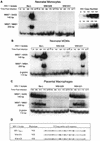Differential tropism and chemokine receptor expression of human immunodeficiency virus type 1 in neonatal monocytes, monocyte-derived macrophages, and placental macrophages
- PMID: 9445034
- PMCID: PMC124612
- DOI: 10.1128/JVI.72.2.1334-1344.1998
Differential tropism and chemokine receptor expression of human immunodeficiency virus type 1 in neonatal monocytes, monocyte-derived macrophages, and placental macrophages
Abstract
Laboratory-adapted (LA) macrophage-tropic (M-tropic) human immunodeficiency virus type 1 (HIV-1) isolates (e.g., HIV-1(Ba-L)) and low-passage primary (PR) isolates differed markedly in tropism for syngeneic neonatal monocytes, monocyte-derived macrophages (MDMs), and placental macrophages (PMs). Newly adherent neonatal monocytes and cultured PMs were highly refractory to infection with PR HIV-1 isolates yet were permissive for LA M-tropic isolates. Day 4 MDMs were also permissive for LA M-tropic isolates and additionally, were permissive for over half the PR isolates tested. Qualitative differences in PR HIV-1 infection of monocytes/MDMs could not be correlated with CD4 levels alone, and in all three cell types the block to PR HIV-1 strain replication preceded reverse transcription. Neonatal monocyte susceptibility to PR HIV-1 strains correlated with increasing CCR-5 expression during maturation. CCR-5 could not be detected on newly adherent (day 1) neonatal monocytes, in contrast to adult monocytes (H. Naif et al., J. Virol. 72:830-836, 1998), but was readily detectable after 4 to 7 days of culture. However, moderate CCR-5 mRNA levels were present in day 1 neonatal monocytes and remained constant during monocyte maturation. CCR-5 was not detectable on the surface of PMs, yet the receptor was present within permeabilized cells. Notably, two brain-derived PR HIV-1 isolates from a single patient, differing in their V3 loops, were discordant in their abilities to infect neonatal monocytes/MDMs and PMs, yet both isolates could infect newly adherent adult monocytes. Together these data strongly suggest that LA HIV-1 isolates are able to infect neonatal monocytes at earlier stages of maturation and lower-level expression of CCR-5 than PR isolates. The differences between neonatal and adult monocytes in susceptibility to PR isolates may also be related to the level of CCR-5 expression.
Figures









Similar articles
-
CD4, CXCR-4, and CCR-5 dependencies for infections by primary patient and laboratory-adapted isolates of human immunodeficiency virus type 1.J Virol. 1997 Feb;71(2):873-82. doi: 10.1128/JVI.71.2.873-882.1997. J Virol. 1997. PMID: 8995603 Free PMC article.
-
Twin studies demonstrate a host cell genetic effect on productive human immunodeficiency virus infection of human monocytes and macrophages in vitro.J Virol. 1996 Nov;70(11):7792-803. doi: 10.1128/JVI.70.11.7792-7803.1996. J Virol. 1996. PMID: 8892900 Free PMC article.
-
Persistent CCR5 utilization and enhanced macrophage tropism by primary blood human immunodeficiency virus type 1 isolates from advanced stages of disease and comparison to tissue-derived isolates.J Virol. 1999 Dec;73(12):9741-55. doi: 10.1128/JVI.73.12.9741-9755.1999. J Virol. 1999. PMID: 10559284 Free PMC article.
-
The influence of cytokines, chemokines and their receptors on HIV-1 replication in monocytes and macrophages.Rev Med Virol. 2003 Jan-Feb;13(1):39-56. doi: 10.1002/rmv.369. Rev Med Virol. 2003. PMID: 12516061 Review.
-
Viral determinants of HIV-1 macrophage tropism.Viruses. 2011 Nov;3(11):2255-79. doi: 10.3390/v3112255. Epub 2011 Nov 15. Viruses. 2011. PMID: 22163344 Free PMC article. Review.
Cited by
-
Cognitive consequences of a sustained monocyte type 1 IFN response in HIV-1 infection.Curr HIV Res. 2014;12(2):77-84. doi: 10.2174/1570162x12666140526113544. Curr HIV Res. 2014. PMID: 24862334 Free PMC article. Review.
-
Expanded tropism of primary human immunodeficiency virus type 1 R5 strains to CD4(+) T-cell lines determined by the capacity to exploit low concentrations of CCR5.J Virol. 1999 Sep;73(9):7842-7. doi: 10.1128/JVI.73.9.7842-7847.1999. J Virol. 1999. PMID: 10438877 Free PMC article.
-
Placental Macrophage (Hofbauer Cell) Responses to Infection During Pregnancy: A Systematic Scoping Review.Front Immunol. 2022 Feb 11;12:756035. doi: 10.3389/fimmu.2021.756035. eCollection 2021. Front Immunol. 2022. PMID: 35250964 Free PMC article.
-
The histone deacetylase inhibitor ITF2357 decreases surface CXCR4 and CCR5 expression on CD4(+) T-cells and monocytes and is superior to valproic acid for latent HIV-1 expression in vitro.J Acquir Immune Defic Syndr. 2010 May 1;54(1):1-9. doi: 10.1097/QAI.0b013e3181d3dca3. J Acquir Immune Defic Syndr. 2010. PMID: 20300007 Free PMC article.
-
Inhibitory effect of glycyrrhizin on the neutrophil-dependent increase of R5 HIV replication in cultures of macrophages.Immunol Cell Biol. 2009 Oct;87(7):554-8. doi: 10.1038/icb.2009.40. Epub 2009 Jun 16. Immunol Cell Biol. 2009. PMID: 19529000 Free PMC article.
References
-
- Alkhatib G, Combadiere C, Broder C C, Feng Y, Kennedy P E, Murphy P M, Berger E A. CC CKR5: a RANTES, MIP-1α, MIP-1β receptor as a fusion cofactor for macrophage-tropic HIV-1. Science. 1996;272:1955–1958. - PubMed
-
- Chandwani S, Greco M, Mittal K, Antoine C, Kraninski K, Borkowsky W. Pathology and human immunodeficiency virus expression in placentas of seropositive women. J Infect Dis. 1991;163:1134–1138. - PubMed
-
- Chang J, Li S, Naif H, Cunningham A L. The magnitude of HIV replication in monocytes and macrophages is influenced by environmental conditions, viral strain, and host cells. J Leukocyte Biol. 1994;56:230–235. - PubMed
Publication types
MeSH terms
Substances
LinkOut - more resources
Full Text Sources
Other Literature Sources
Medical
Research Materials

